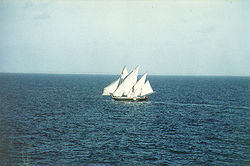
The Patamar (Portuguese), (English: Pattamar, Patimar, French : Patemar, Patmar), [1] is a type of Indian Dhow. It was traditionally used in the western coast of the Indian subcontinent as a cabotage vessel between Gujarat and Ceylon, usually for the transport of rice. Some can still be seen on the Malabar Coast.
